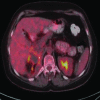Adrenal angiosarcoma
- PMID: 30023982
- PMCID: PMC6048635
- DOI: 10.5152/turkjsurg.2017.3141
Adrenal angiosarcoma
Abstract
Adrenal angiosarcoma is an uncommon neoplasm that derives from the vascular endothelium; due to its biological behavior, it should be distinguished from other adrenal tumors. We herein report a case of a 57-year-old woman with diagnosis of an adrenal tumor that was suspected to be malignant. The specimen was histopathologically proved to be an angiosarcoma. The patient was suffering from right upper quadrant pain; after laboratory and radiological workup, a non-functioning right adrenal mass, 14 cm in size, was recognized. A right subcostal incision was made, and adrenalectomy was performed successfully with tumor-free surgical margins. Two months after the operation, a positron emission tomography-computed tomography scan was ordered for follow-up. No tumor tissue or any other metastatic foci remained. The patient had been referred to our medical oncology department and underwent retroperitoneal radiotherapy. However, unfortunately, the patient died due to cardiac insufficiency during the follow-up period.
Keywords: Adrenal angiosarcoma; adrenal gland; adrenal incidentaloma; malignant vascular tumors.
Conflict of interest statement
Conflict of Interest: The authors have no conflicts of interest to declare.
Figures





References
LinkOut - more resources
Full Text Sources
Other Literature Sources
